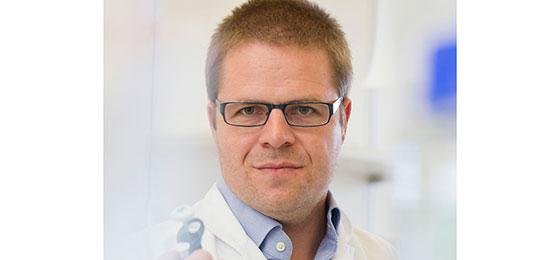"Without the membrane it's game over for bacteria."

A study just published in the journal "Nature" describes the discovery of a new class of antibiotics. Co-author Sebastian Hiller from the Center for Molecular Life Sciences of the University of Basel explains what this means.
The biopharmaceutics company Polyphor has developed, together with the Universities of Zurich and Basel as well as ETH Zurich, novel agents to fight gram-negative bacteria. In lab experiments and animal models, the substances effectively combat a wide array of multi-resistant pathogens. A promising candidate is in preclinical development.
Professor Hiller, why is it so important to find new agents to fight gram-negative bacteria?
There is a list of the six most dangerous, resistant 'hospital bugs', which are known as the ESKAPE pathogens. Four of them are gram-negative and cause life-threatening infections like pneumonia and blood poisoning. There are still some reserve antibiotics against gram-negative bacteria, but resistance to these agents has been growing fast over the past few years. According to some forecasts, in 20 or 30 years' time the number of fatalities caused by resistant pathogens will equal the number caused by cancer. New antibiotics are thus highly desirable.
The last new class of antibiotics against gram-negative bacteria was discovered back in the 1960s. Where does the problem lie?
The main difficulty is finding a good place to attack. Bacteria have learnt to protect themselves against attack over millions of years of evolution. They only have few weak spots.
But Polyphor has now found such a weak spot. What do the substances do?
They prevent the gram-negative bacteria from growing an outer membrane. These membranes consist of lipids and about 80-100 different proteins, all of which take on important roles, for example in transporting substances or defending against toxic threats. Without an outer membrane, it's 'game over' for the bacteria. They are no longer able to divide, they burst open and they are a lot more vulnerable to attacks by the patient's immune system.
The new agent targets a specific membrane protein called BamA. What function does this protein carry out for the bacteria?
BamA is part of the so-called BAM complex, which resides in the outer membrane. Its role is to receive proteins from inside the bacterial cells, fold them in the right way and insert them into the membrane. BamA is the most important component of this machinery. Experiments have shown that bacteria cannot survive without BamA. Hence this is an area where bacteria are very vulnerable, and it has been a focal point for the development of new antibiotics for some time.
Your contribution to this project was studying precisely how the process works. What did you find out?
My research team has been studying the structural biology of the BAM complex for nearly ten years. We have already established that BamA normally exists in an open and in a closed form. In the open form, BamA receives the proteins, folds them and inserts them into the membrane. Now we have also been able to show that the new antibacterial candidate ensures that BamA can no longer open, remaining instead in a closed and inactive state. This kills off the bacteria.
Do you think other agents that attack BamA will be found in the future?
The substances described in the article are the first known compounds to attack the BAM complex. That is why we are speaking of a new class of agents. Further natural or synthetic substances that latch onto BamA may well be found in the near future.
Isn't there a danger of the bacteria becoming resistant to the new antibiotics as well?
To say that this will never happen would be unrealistic. And resistance has indeed been found in in vitro experiments, but the rate at which it was produced was slower than with other classes of antibiotics. How resistance will occur in vivo remains to be seen. Sensible use of the new antibiotics should also help to minimize resistance. This calls for good public health management - another important area addressed by NRP 72.
Short bio
Sebastian Hiller is professor of structural biology at the Biozentrum of the University of Basel. With the help of magnetic resonance spectroscopy (NMR) he is decoding the structure and function of proteins at atomic level. One of the mainstays of his work for NRP 72 is investigating the processes that occur when gram-negative bacteria build an outer membrane.
